Carica papaya Crude Extracts Are an Efficient Source of Environmentally Friendly Biogenic Synthesizers of Silver Nanoparticles
Abstract
:1. Introduction
2. Materials and Methods
3. Results
3.1. Callus Induction and Propagation
3.2. Biosynthesis of AgNPs from Carica papaya Extracts
3.3. Characterization of AgNPs through SEM and XRD
3.4. Antimicrobial Activity
4. Discussion
5. Conclusions
Author Contributions
Funding
Institutional Review Board Statement
Informed Consent Statement
Data Availability Statement
Acknowledgments
Conflicts of Interest
References
- Lim, X.Y.; Chan, J.S.W.; Japri, N.; Lee, J.C.; Tan, T.Y.C. Carica papaya L. Leaf: A systematic scoping review on biological safety and herb-drug interactions. Evid. Based Complement. Altern. Med. 2021, 7, 5511221. [Google Scholar] [CrossRef]
- FAOSTAT. Crop Production; FAO: Rome, Italy, 2012; Available online: http://faostat.fao.org/site/567/default.aspx#ancor (accessed on 19 September 2023).
- Mude, N.; Ingle, A.; Gade, A.; Rai, M. Synthesis of silver nanoparticles using callus extract of Carica papaya—A first report. J. Plant Biochem. Biotechnol. 2009, 18, 83–86. [Google Scholar] [CrossRef]
- Jimenez, B.C.; Johnson, M.E.; Bustos, A.R.M.; Murphy, K.E.; Winchester, M.R.; Baudrit, J.R.V. Silver nanoparticles: Technological advances, societal impacts, and metrological challenges. Front. Chem. 2017, 39, 113–123. [Google Scholar] [CrossRef]
- Ahmad, S.; Munir, S.; Zeb, N.; Ullah, A.; Khan, B.; Ali, J.; Ali, S. Green nanotechnology: A review on green synthesis of silver nanoparticles—An ecofriendly approach. Int. J. Nanomed. 2019, 14, 5087–5107. [Google Scholar] [CrossRef]
- Das, D.; Bhattacharyya, S.; Bhattacharyya, M.; Mandal, P. Green chemistry inspired formation of bioactive stable colloidal nanosilver and its wide-spectrum functionalised properties for sustainable industrial escalation. Results Chem. 2022, 4, 100533. [Google Scholar] [CrossRef]
- Zofair, S.F.F.; Ahmad, S.; Hashmi, M.A.; Khan, S.H.; Khan, M.A.; Younus, H. Catalytic roles, immobilization and management of recalcitrant environmental pollutants by laccases: Significance in sustainable green chemistry. J. Environ. Manag. 2022, 309, 114676. [Google Scholar] [CrossRef]
- Roy, T.S.; Fahim, M.R.; Islam, M.T.; Gafur, M.A.; Ferdous, T. Eco-friendly Synthesis of Silver Nanoparticles for Multifunctional Protective Cotton and Flax Fabrics. J. Nat. Fibers 2022, 19, 13681–13693. [Google Scholar] [CrossRef]
- Malik, N.; Sengar, R.S.; Yadav, M.K.; Singh, S.K.; Singh, G.; Kumar, M. Effect of Different Plant Growth Regulators on In-Vitro Callus Induction in Carica papaya. Int. J. Curr. Microbiol. Appl. Sci. 2019, 8, 1217–1225. [Google Scholar] [CrossRef]
- Komal, R.; Arya, V. Biosynthesis and characterization of silver nanoparticles from aqueous leaf extracts of Carica papaya and its antibacterial activity. Int. J. Nanomater. Biostruct. 2013, 3, 17–20. [Google Scholar]
- Manisha, D.R.; Merugu, R.; Vijaybabu, A.R.; Pratap Rudra, M.P. Microwave-assisted biogenic synthesis of silver nanoparticles using dried seed extract of Coriandrum sativum, characterization and antimicrobial activity. Int. J. ChemTech Res. 2014, 6, 3957–3961. [Google Scholar]
- Pattanayak, S.; Mollick, M.M.R.; Maity, D.; Chakraborty, S.; Dash, S.K.; Chattopadhyay, S.; Chakraborty, M. Butea monosperma bark extract mediated green synthesis of silver nanoparticles: Characterization and biomedical applications. J. Saudi Chem. Soc. 2017, 21, 673–684. [Google Scholar] [CrossRef]
- Jain, D.; Daima, H.K.; Kachhwaha, S.; Kothari, S.L. Synthesis of plant-mediated silver nanoparticles using papaya fruit extract and evaluation of their antimicrobial activities. Dig. J. Nanomater. Biostruct. 2009, 4, 557–563. [Google Scholar]
- Balavijayalakshmi, J.; Ramalakshmi, V. Carica papaya peel mediated synthesis of silver nanoparticles and its antibacterial activity against human pathogens. J. Appl. Res. Technol. 2017, 15, 413–422. [Google Scholar] [CrossRef]
- Anjum, S.; Khan, A.K.; Qamar, A.; Fatima, N.; Drouet, S.; Renouard, S.; Hano, C. Light Tailoring: Impact of UV-C Irradiation on Biosynthesis, Physiognomies, and Clinical Activities of Morus macroura-Mediated Monometallic (Ag and ZnO) and Bimetallic (Ag–ZnO) Nanoparticles. Int. J. Mol. Sci. 2021, 22, 11294. [Google Scholar] [CrossRef] [PubMed]
- Lashin, I.; Fouda, A.; Gobouri, A.A.; Azab, E.; Mohammedsaleh, Z.M.; Makharita, R.R. Antimicrobial and In Vitro Cytotoxic Efficacy of Biogenic Silver Nanoparticles (Ag-NPs) Fabricated by Callus Extract of Solanum incanum L. Biomolecules 2021, 11, 341. [Google Scholar] [CrossRef]
- Göl, F.; Aygün, A.; Seyrankaya, A.; Gür, T.; Yenikaya, C.; Şen, F. Green synthesis and characterization of Camellia sinensis mediated silver nanoparticles for antibacterial ceramic applications. Mater. Chem. Phys. 2020, 250, 123037. [Google Scholar] [CrossRef]
- Sarma, P.P.; Barman, K.; Baruah, P.K. Green synthesis of silver nanoparticles using Murraya koenigii leaf extract with efficient catalytic, antimicrobial, and sensing properties towards heavy metal ions. Inorg. Chem. Commun. 2023, 152, 110676. [Google Scholar] [CrossRef]
- Aina, A.D.; Owolo, O.; Adeoye-Isijola, M.; Olukanni, O.D.; Lateef, A.; Egbe, T.; Abbas, S.H. Ecofriendly production of silver nanoparticles from the seeds of Carica papaya and its larvicidal and antibacterial efficacy against some selected bacterial pathogens. IOP Conf. Ser. Mater. Sci. Eng. 2020, 805, 12–38. [Google Scholar] [CrossRef]
- Mortazavi-Derazkola, S.; Yousefinia, A.; Naghizadeh, A.; Lashkari, S.; Hosseinzadeh, M. Green synthesis and characterization of silver nanoparticles using Elaeagnus angustifolia bark extract and study of Its antibacterial effect. J. Polym. Environ. 2021, 29, 3539–3547. [Google Scholar] [CrossRef]
- Pandit, R. Green synthesis of silver nanoparticles from seed extract of Brassica nigra and its antibacterial activity. Nusant. Biosci. 2015, 7, 15–19. [Google Scholar] [CrossRef]
- Zia, M.; Chaudhary, M.F. Green synthesis of silver nanoparticles from grape and tomato juices and evaluation of biological activities. IET Nanobiotechnol. 2017, 11, 193–199. [Google Scholar] [CrossRef] [PubMed]
- John, T.; Parmar, K.A.; Kotval, S.C.; Jadhav, J. Synthesis, characterization, antibacterial and anticancer properties of silver nanoparticles synthesized from Carica papaya peel extract. Int. J. Nanosci. Nanotechnol. 2021, 17, 23–32. [Google Scholar]
- Prasad, S.R.; Teli, S.B.; Ghosh, J.; Prasad, N.R.; Shaikh, V.S.; Nazeruddin, G.M.; Al-Sehemi, A.G.; Patel, I.; Shaikh, Y.I. A review on bio-inspired synthesis of silver nanoparticles: Their antimicrobial efficacy and toxicity. Eng. Sci. 2021, 16, 90–128. [Google Scholar] [CrossRef]
- Anjum, S.; Abbasi, B.H. Thidiazuron-enhanced biosynthesis and antimicrobial efficacy of silver nanoparticles via improving phytochemical reducing potential in callus culture of Linum usitatissimum L. Int. J. Nanomed. 2016, 11, 715–728. [Google Scholar] [CrossRef]
- Aref, M.S.; Salem, S.S. Bio-callus synthesis of silver nanoparticles, characterization, and antibacterial activities via Cinnamomum camphora callus culture. Biocatal. Agric. Biotechnol. 2020, 27, 77–90. [Google Scholar] [CrossRef]
- Aritonang, H.F.; Koleangan, H.; Wuntu, A.D. Synthesis of Silver Nanoparticles Using Aqueous Extract of Medicinal Plants’ (Impatiens balsamina and Lantana camara) Fresh Leaves and Analysis of Antimicrobial Activity. Int. J. Microbiol. 2019, 2019, 8642303. [Google Scholar] [CrossRef]
- Mussin, J.; Giusiano, G. Biogenic silver nanoparticles as antifungal agents. Front. Chem. 2022, 10, 1023542. [Google Scholar] [CrossRef] [PubMed]
- Saxena, J.; Ayushi, K.M. Evaluation of Sclerotinia sclerotiorum MTCC 8785 as a biological agent for the synthesis of silver nanoparticles and assessment of their antifungal potential against Trichoderma harzianum MTCC 801. Environ. Res. 2023, 216, 114752. [Google Scholar] [CrossRef]
- Zamana, Y.; Ishaquea, M.Z.; Sattarb, R.; Rehmanb, M.M.; Sabac, I.; Kanwala, S.; Akrama, M.; Shahzada, M.; Kanwald, H.; Qadirb, R.; et al. Antibacterial potential of silver nanoparticles synthesized using tri-sodium citrate via controlled exploitation of temperature. Dig. J. Nanomater. Biostruct. 2022, 17, 979–987. [Google Scholar] [CrossRef]
- Revathi, E.; Yaku, G.; Unnisa, S.A.; Malyala, P.; Praveen, V. Microwave assisted green synthesis of silver nanoparticles from Carica papaya fruit extract: Characterization and detection of Fe3+ and Hg2+ ions. Mater. Today Proc. 2023. [Google Scholar] [CrossRef]
- Arsene, M.M.J.; Viktorovna, P.I.; Alla, M.; Mariya, M.; Davares, A.K.L.; Carime, B.Z.; Anatolievna, G.O.; Vyacheslavovna, Y.N.; Vladimirovna, Z.A.; Andreevna, S.L.; et al. Antimicrobial activity of phytofabricated silver nanoparticles using Carica papaya L. against Gram-negative bacteria. Vet. World 2023, 16, 1301. [Google Scholar] [CrossRef] [PubMed]



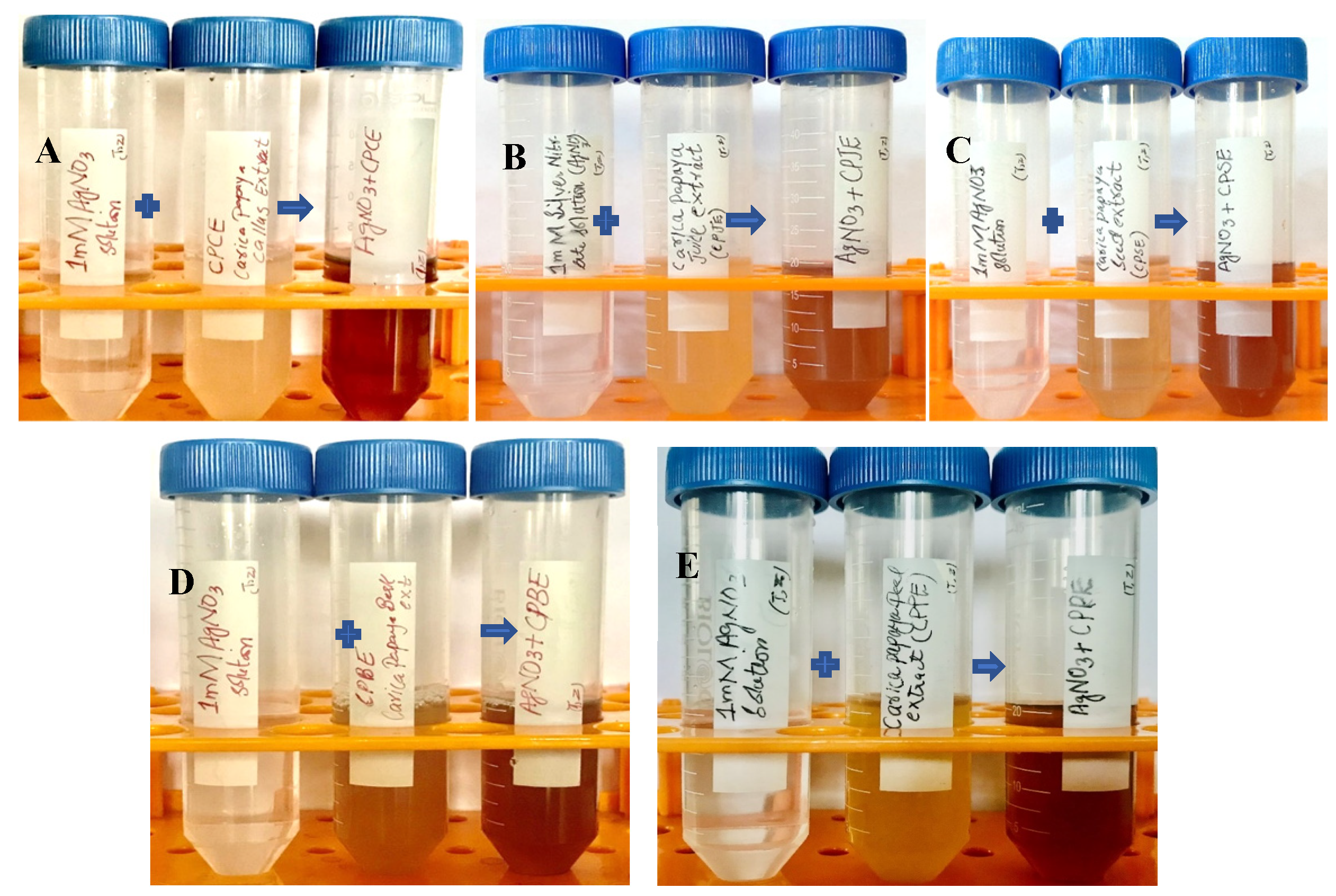

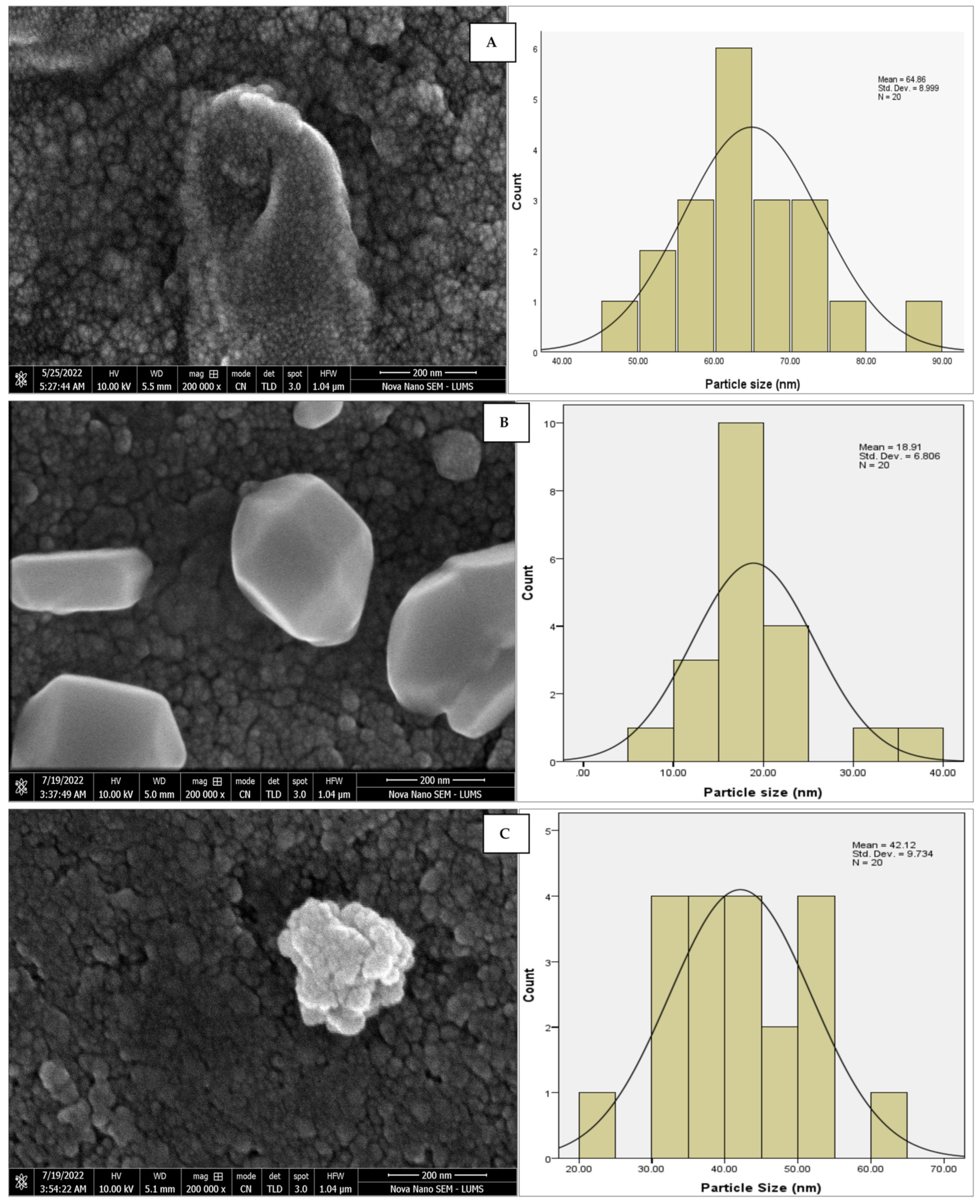






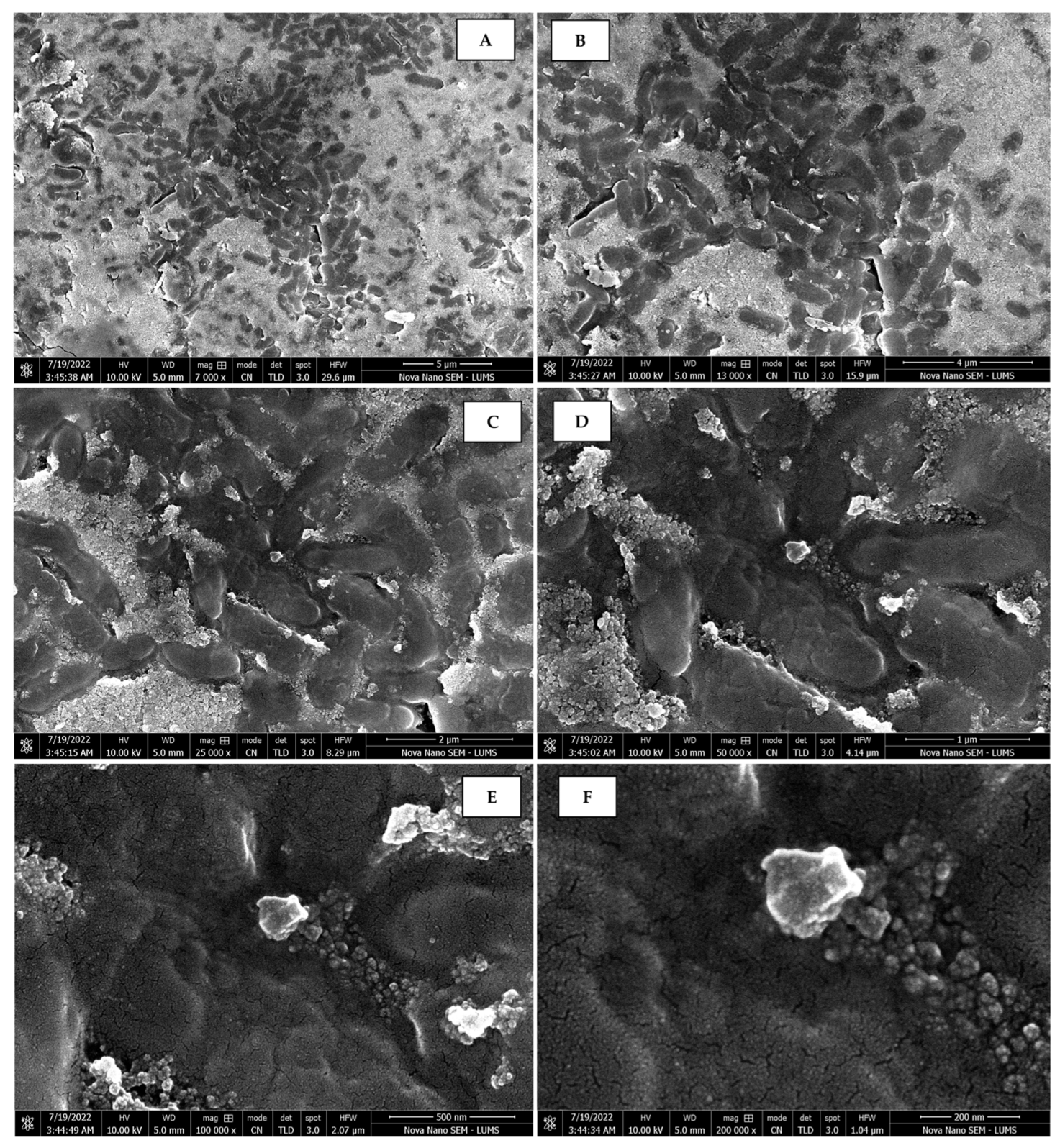
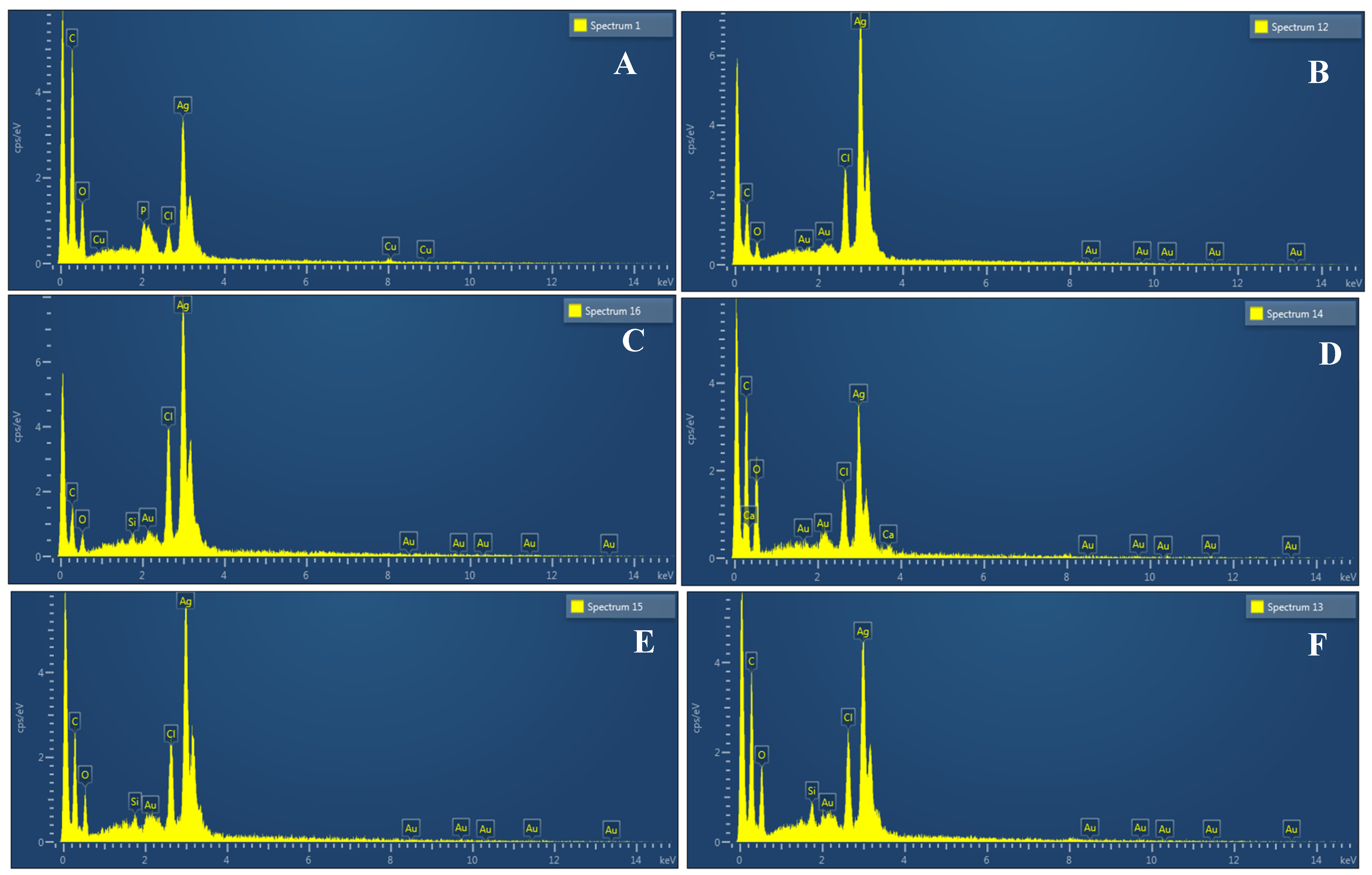



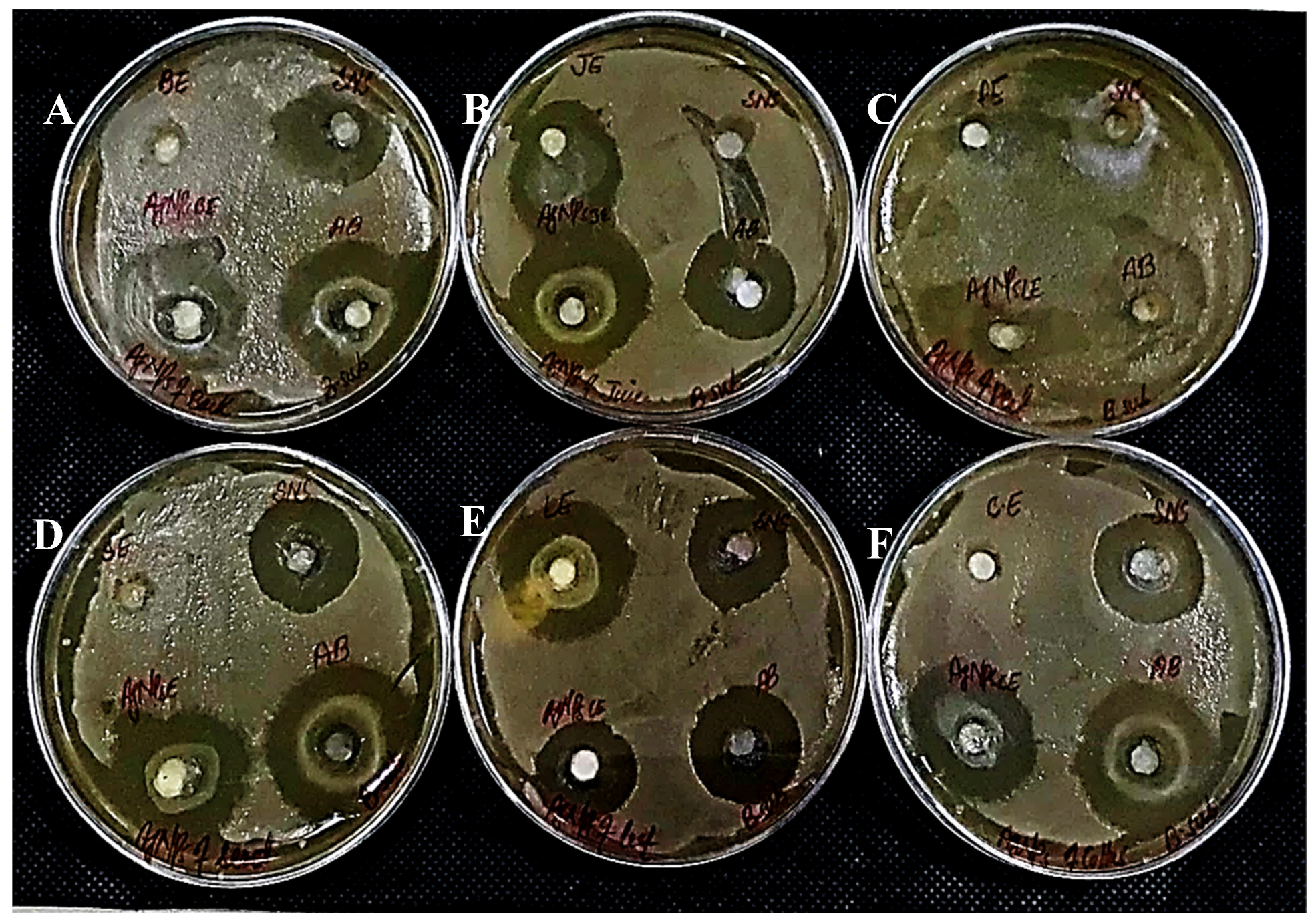


| AgNPs Synthesized Using Plant Extract | Average Size Distribution (nm) of AgNPs | Shapes of AgNPs Observed in SEM |
|---|---|---|
| Leaf extract | 64.83 | Elongated rod type |
| Callus extract | 18.91 | Nano-rods and triangular |
| fruit Juice extract | 42.12 | Agglomerated |
| seed Extract | 65.83 | Polydispersed |
| bark Extract | 32.69 | Elongated rod type |
| peel Extract | 64.76 | Polydispersed |
| Bacterial Strain | Sample Type | Zone of Inhibition (mm) (15 μL/Well) | |||||
|---|---|---|---|---|---|---|---|
| AgNPs of BE | AgNPs of JE | AgNPs of PE | AgNPs of SE | AgNPs of LE | AgNPs of CE | ||
| Xanthomonas campestris | Negative Control (extracts) | 3 ± 0.96 | 5.5 ± 0.23 | 3 ± 1.54 | 6 ± 1.22 | 7.5 ± 1.2 | 8 ± 0.88 |
| Positive Control (SNS) | 1.5 ± 0.41 | 1 ± 0.51 | 2 ± 0.77 | 2.5 ± 1.08 | 1.5 ± 0.15 | 1 ± 0.86 | |
| AgNPs | 12 ± 1.5 | 11 ± 1.74 | 17 ± 1.09 | 10 ± 2.13 | 18 ± 1.14 | 19 ± 1.42 | |
| Tetracycline | 14 ± 1.7 | 15 ± 2.64 | 10 ± 2.41 | 19 ± 2.93 | 20 ± 2.82 | 20 ± 2.92 | |
| Erwinia carotovera | Negative Control (extracts) | 5 ± 0.7 | 5 ± 0.92 | 5 ± 0.9 | 5 ± 0.94 | 5.5 ± 1.19 | 6.5 ± 1.23 |
| Positive Control (SNS) | 6 ± 1.07 | 7.5 ± 1.33 | 6.5 ± 1.1 | 8 ± 1.27 | 6.5 ± 1.4 | 7 ± 1.6 | |
| AgNPs | 7.5 ± 0.66 | 8.5 ± 1.64 | 12 ± 1.54 | 11 ± 1.25 | 10 ± 1.87 | 10 ± 1.15 | |
| Tetracycline | 10 ± 0.99 | 9.5 ± 1.79 | 11 ± 1.73 | 13 ± 1.55 | 14 ± 1.78 | 12 ± 1.23 | |
| Bacillus subtilis | Negative Control (extracts) | 1 ± 0.31 | 6.5 ± 0.38 | 1.75 ± 1.0 | 1.5 ± 0.99 | 7 ± 1.2 | 1 ± 0.99 |
| Positive Control (SNS) | 6.5 ± 0.64 | 4 ± 1.28 | 3.5 ± 1.20 | 5.5 ± 1.1 | 4 ± 1.56 | 4 ± 1.23 | |
| AgNPs | 6 ± 1.62 | 7 ± 1.55 | 6.5 ± 1.41 | 7.5 ± 1.3 | 7.25 ± 1.66 | 7 ± 1.62 | |
| Tetracycline | 7 ± 1.33 | 7 ± 1.42 | 4.5 ± 1.09 | 6 ± 1.2 | 7.5 ± 1.88 | 7.5 ± 1.52 | |
| Sample Type | Zone of Inhibition (mm) (15 μL/Well) against Aspergillus niger | |||||
|---|---|---|---|---|---|---|
| AgNPs of PE | AgNPs of CE | AgNPs of BE | AgNPs of JE | AgNPs of LE | AgNPs of SE | |
| Negative Control (Extract) | 1 ± 0.99 | 2 ± 0.87 | 1 ± 0.65 | 1 ± 0.41 | 1 ± 0.88 | 2 ± 0.56 |
| Positive Control (SNS) | 5.0 ± 1.1 | 3.5 ± 1.56 | 4 ± 1.3 | 5 ± 1.5 | 3 ± 1.05 | 3 ± 1.08 |
| AgNPs | 14 ± 1.66 | 10 ± 1.98 | 12 ± 1.72 | 10 ± 1.71 | 12 ± 1.9 | 10 ± 1.23 |
| Fluconazole | 10 ± 1.67 | 9 ± 1.31 | 10 ± 1.98 | 9.75 ± 2.09 | 10 ± 1.74 | 11 ± 2.51 |
| Sample Type | Zone of Inhibition (mm) (15 μL/well) against Fusarium oxysporum | |||||
| AgNPs of BE | AgNPs of JE | AgNPs of PE | AgNPs of SE | AgNPs of LE | AgNPs of CE | |
| Negative Control (Extract) | 3 ± 0.65 | 2 ± 0.23 | 1 ± 0.38 | 2 ± 1.07 | 1 ± 0.87 | 2 ± 1.1 |
| Positive Control (SNS) | 1 ± 0.45 | 1 ± 0.57 | 1 ± 0.99 | 1 ± 0.23 | 3 ± 1.1 | 2.5 ± 1.23 |
| AgNPs | 4 ± 1.56 | 3 ± 1.89 | 6 ± 1.27 | 4.5 ± 1.17 | 7 ± 2.1 | 4.5 ± 1.32 |
| Fluconazole | 6 ± 1.76 | 4 ± 1.13 | 8.5 ± 1.12 | 4.75 ± 1.56 | 8.5 ± 2.01 | 3.90 ± 2.45 |
Disclaimer/Publisher’s Note: The statements, opinions and data contained in all publications are solely those of the individual author(s) and contributor(s) and not of MDPI and/or the editor(s). MDPI and/or the editor(s) disclaim responsibility for any injury to people or property resulting from any ideas, methods, instructions or products referred to in the content. |
© 2023 by the authors. Licensee MDPI, Basel, Switzerland. This article is an open access article distributed under the terms and conditions of the Creative Commons Attribution (CC BY) license (https://creativecommons.org/licenses/by/4.0/).
Share and Cite
Jahangir, G.Z.; Anjum, T.; Rashid, N.; Sadiq, M.; Farooq, R.; Akhtar, M.; Hussain, S.; Iftikhar, A.; Saleem, M.Z.; Shaikh, R.S. Carica papaya Crude Extracts Are an Efficient Source of Environmentally Friendly Biogenic Synthesizers of Silver Nanoparticles. Sustainability 2023, 15, 16633. https://doi.org/10.3390/su152416633
Jahangir GZ, Anjum T, Rashid N, Sadiq M, Farooq R, Akhtar M, Hussain S, Iftikhar A, Saleem MZ, Shaikh RS. Carica papaya Crude Extracts Are an Efficient Source of Environmentally Friendly Biogenic Synthesizers of Silver Nanoparticles. Sustainability. 2023; 15(24):16633. https://doi.org/10.3390/su152416633
Chicago/Turabian StyleJahangir, Ghulam Zahara, Tayyabah Anjum, Naim Rashid, Madeha Sadiq, Rida Farooq, Mubeen Akhtar, Sana Hussain, Anwaar Iftikhar, Muhammad Zafar Saleem, and Rehan Sadiq Shaikh. 2023. "Carica papaya Crude Extracts Are an Efficient Source of Environmentally Friendly Biogenic Synthesizers of Silver Nanoparticles" Sustainability 15, no. 24: 16633. https://doi.org/10.3390/su152416633





